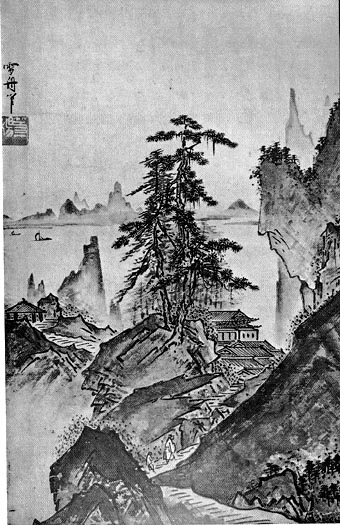| architecture |
| calligraphy |
| ceramics |
| clothing |
| comics |
| gardens |
| lacquerwork |
| literature |
| movies |
| music |
| painting |
| poetry |
| sculpture |
| tea ceremony |
| television |
| theatre |
| weaponry |
| thematic routes |
| timeline |
| the site |
context: painting > general comments

|
a landscape by Zen painter Sesshu |
Zen
The aesthetics of Zen were best defined in Shin'ichi Hisamatsu's Zen And The Fine Arts, where he identified seven qualities that Zen art should have - they are all of equal importance, and indeed a really fine piece of Zen art should express all of them at once. They are all expressions of the Zen mind, so are inextricably bound together.
- Fukinsei, asymmetry: This was very contrary to previous Buddhist art, which had leaned towards diagrammatic mandalas, and to the reaching for formal perfection visible in much Heian art. It can be seen in the arrangements of uneven groups of rocks in Zen dry gardens, in the not-quite-circular tea vessels, in the one-corner composition so characteristic of Japanese painting. It is not a deliberate, showy asymmetry so much as something arising from not seeking symmetry, and symmetry should be understood to include such ideas as evenness, formality, balance, grace and perfection.
- Kanso, simplicity, sparseness: a lack of clutter, of decoration, of encumbrance. Simplicity as an expression of mu, nothingness. It is this that led to black ink on paper being the dominant approach to Zen painting, and the minimalism of the tea room.
- Koko, translated by various sources as astringency, austere sublimity, lofty dryness. It's a pared-down dryness suggestive of age, withering, winter, rather than the abundance of youth, summer. The dry Zen gravel gardens are a good example of this. It has something to do with wisdom - shedding the irrelevant encumbrances of youth, honing it to what matters.
- Shizen, naturalness. Not naivety, but the simplicity that comes from deep understanding. One Zen bamboo painter was asked by an indignant client how long it had taken him to paint that bamboo, obviously the work of a handful of brushstrokes: "Fifty years and five minutes: fifty years studying the bamboo, and five minutes to paint it." This concept also includes an idea very close to the west's truth to materials. It also links to the idea of doing things without conscious artistry.
- Yugen, something like reserved profundity. It's a subtle, spiritual depth. Works are supposed to be difficult and demanding, but to offer the right rewards if one looks hard and with wisdom. There is a suggestion also of darkness, but we are talking more of the peaceful dimness of late evening or a shady garden than any kind of gloom or abyssal darkness.
- Daisozu, lack of attachment. An untrammelled mind, with no devotion to any dogma or ideology, no habits or formulae holding one back. Freedom of thought. This includes a lack of attachment to Zen itself, and more or less explains the famous idea of killing the Buddha.
- Sei-jaku, tranquility. The artist's spirit should be calm before touching the artwork. You regularly see Zen painters and calligraphers poised for some moments, brush in hand, emptying their minds before touching the work.
There are also a few other terms used of Zen artworks in particular. Aware is a kind of sad beauty; wabi is about poignant nuances of sparseness, even poverty, and was central to Rikyu's tea ceremony; sabi is about a patina of age, and carries nuances of grace and loneliness. The last two are both strongly linked to koko above.
Oddly, despite this austerity and sadness and mental discipline, there is much good humour in Zen works (go back to the monkey on the Welcome page for an example of that), some of which is about undermining human pride, and about showing the absurdity of so many actions. Zen artists don't use this only in an outward way, but about their own most revered figures.
forwards: Chinese influence
sideways: section on Zen generally
